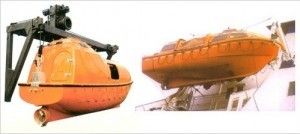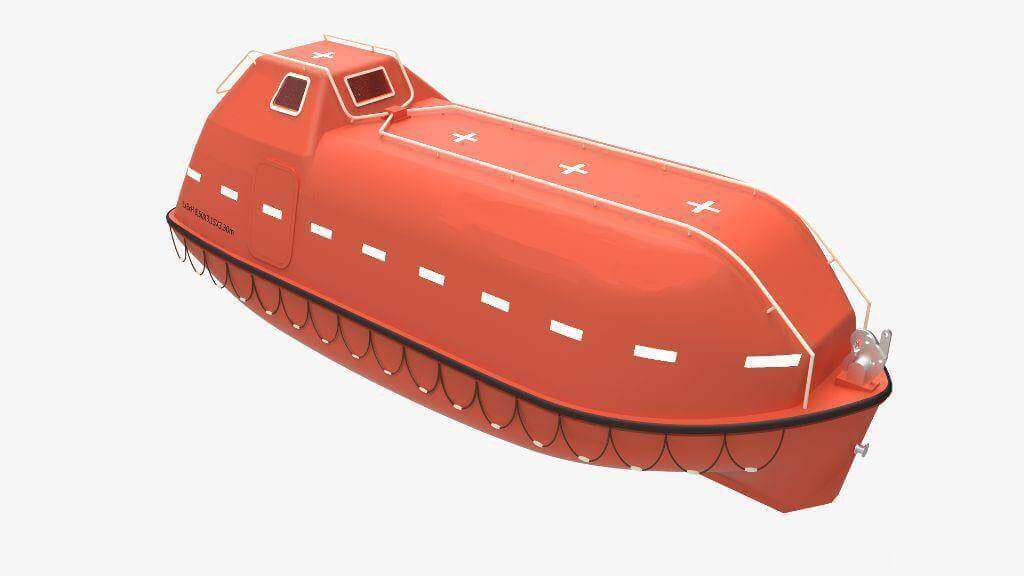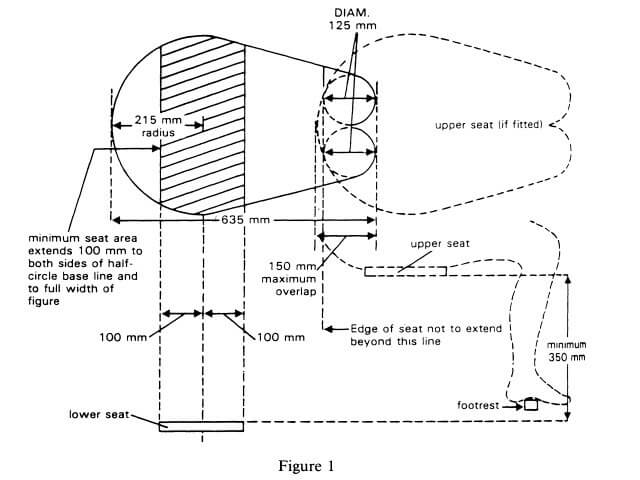Requirements
All lifeboats shall be properly constructed and shall be of such form and proportions that they have ample stability in a seaway and sufficient freeboard when loaded with their full complement of persons and equipment. All lifeboats shall have rigid hulls and shall be capable of maintaining positive stability when in an upright position in calm water and loaded with their full complement of persons and equipment and holed in any one location below the waterline, assuming no loss of buoyancy material and no other damage.
1. Each lifeboat shall be fitted with a certificate of approval, endorsed by the Administration, containing at least the following items:
- Manufacturer’s name and address;
- Lifeboat model and serial number;
- Month and year of manufacture;
- Number of persons the lifeboat is approved to carry; and
- With approval information including the Administration which approved it, and any operational restrictions.
The certifying organization shall provide the lifeboat with a certificate of approval which, in addition to the above items, specifies:
- Number of the certificate of approval;
- Material of hull construction, in such detail as to ensure that compatibility problems in repair should not occur;
- Total mass fully equipped and fully manned;
- Statement of approval.
2. All lifeboats shall be of sufficient strength to:
- Enable them to be safely launched into the water when loaded with their full complement of persons and equipment;
- Be capable of being launched and towed when the ship is making headway at a speed of 5 knots in calm water.
3. Hulls and rigid covers shall be fire-retardant or non-combustible.
4. Seating shall be provided on thwarts, benches or fixed chairs which are constructed so as to be capable of supporting:
- A static load equivalent to the number of persons each weighing 100 kg for which spaces are provided in compliance with the seating requirements shown in Figure 1.
- A load of 100 kg in any single seat location when a lifeboat to be launched by falls is dropped into the water from a height of at least 3 m;
A load of 100 kg in any single seat location when a free-fall lifeboat is launched from a height of at least 1.3 times its free-fall certification height.
5. Except for free-fall lifeboats, each lifeboat to be launched by falls shall be of sufficient strength to withstand a load, without residual deflection on removal of that load:
- In the case of boats with metal hulls, 1.25 times the total mass of the lifeboat when loaded with its full complement of persons and equipment; or
- In the case of other boats, twice the total mass of the lifeboat when loaded with its full complement of persons and equipment.
6. Except for free-fall lifeboats, each lifeboat to be launched by falls shall be of sufficient strength to withstand, when loaded with its full complement of persons and equipment and with, where applicable, skates or fenders in position, a lateral impact against the ship’s side at an impact velocity of at least 3.5 m/s and also a drop into the water from a height of at least 3 m.
7. The vertical distance between the floor surface and the interior of the enclosure or canopy over 50% of the floor area shall be:
- Not less than 1.3 m for a lifeboat permitted to accommodate nine persons or less;
- Not less than 1.7 m for a lifeboat permitted to accommodate 24 persons or more; and
- Not less than the distance as determined by linear interpolation between 1.3 m and 1.7 m for a lifeboat permitted to accommodate between nine and 24 persons.
8. No lifeboat shall be approved to accommodate more than 150 persons.
The number of persons which a lifeboat to be launched by falls shall be permitted to accommodate shall be equal to the lesser of:
- The number of persons having an average mass of 75 kg, all wearing lifejackets, that can be seated in a normal position without interfering with the means of propulsion or the operation of any of the lifeboat’s equipment; or
- The number of spaces that can be provided on the seating arrangements in accordance with figure 1. The shapes may be overlapped as shown, provided footrests are fitted and there is sufficient room for legs and the vertical separation between the upper and lower seat is not less than 350 mm.
9. Each seating position shall be clearly indicated in the lifeboat.
Access into lifeboats
- Every passenger ship lifeboat shall be so arranged that it can be rapidly boarded by its full complement of persons. Rapid disembarkation shall also be possible.
- Every cargo ship lifeboat shall be so arranged that it can be boarded by its full complement of persons in not more than 3 min from the time the instruction to board is given. Rapid disembarkation shall also be possible.
- Lifeboats shall have a boarding ladder that can be used at any boarding entrance of the lifeboat to enable persons in the water to board the lifeboat. The lowest step of the ladder shall be not less than 0.4 m below the lifeboat’s light waterline.
- The lifeboat shall be so arranged that helpless people can be brought on board either from the sea or on stretchers.
- All surfaces on which persons might walk shall have a non-skid finish.
Lifeboat buoyancy
All lifeboats shall have inherent buoyancy or shall be fitted with inherently buoyant material which shall not be adversely affected by seawater, oil or oil products, sufficient to float the lifeboat with all its equipment on board when flooded and open to the sea. Additional inherently buoyant material, equal to 280 N of buoyant force per person shall be provided for the number of persons the lifeboat is permitted to accommodate. A buoyant material, unless in addition to that required above, shall not be installed external to the hull of the lifeboat.
Lifeboat freeboard and stability
All lifeboats shall be stable and have a positive GM value when loaded with 50% of the number of persons the lifeboat is permitted to accommodate in their normal positions to one side of the centreline.
Under the condition of loading described above:
- Each lifeboat with side openings near the gunwale shall have a freeboard, measured from the waterline to the lowest opening through which the lifeboat may become flooded, of at least 1.5% of the lifeboat’s length or 100 mm, whichever is the greater;
- Each lifeboat without side openings near the gunwale shall not exceed an angle of heel of 20° and shall have a freeboard, measured from the waterline to the lowest opening through which the lifeboat may become flooded, of at least 1.5% of the lifeboat’s length or 100 mm, whichever is the greater.
Lifeboat propulsion
Every lifeboat shall be powered by a compression ignition engine. No engine shall be used for any lifeboat if its fuel has a flashpoint of 43°C or less (closed cup test).
The engine shall be provided with either a manual starting system, or a power starting system with two independent rechargeable energy sources. Any necessary starting aids shall also be provided. The engine starting systems and starting aids shall start the engine at an ambient temperature of -15°C within 2 min of commencing the start procedure unless, in the opinion of the Administration having regard to the particular voyages in which the ship carrying the lifeboat is constantly engaged, a different temperature is appropriate. The starting systems shall not be impeded by the engine casing, seating or other obstructions. The speed of a lifeboat when proceeding ahead in calm water, when loaded with its full complement of persons and equipment and with all engine powered auxiliary equipment in operation, shall be at least 6 knots and at least 2 knots when towing a 25-person life-raft loaded with its full complement of persons and equipment or its equivalent. Sufficient fuel, suitable for use throughout the temperature range expected in the area in which the ship operates, shall be provided to run the fully loaded lifeboat at 6 knots for a period of not less than 24 h.
Water-resistant instructions for starting and operating the engine shall be provided and mounted in a conspicuous place near the engine starting controls.
Lifeboat fittings
All lifeboats except free-fall lifeboats shall be provided with at least one drain valve fitted near the lowest point in the hull, which shall automatically open to drain water from the hull when the lifeboat is not waterborne and shall automatically close to prevent entry of water when the lifeboat is waterborne. Each drain valve shall be provided with a cap or plug to close the valve, which shall be attached to the lifeboat by a lanyard, a chain, or other suitable means. Drain valves shall be readily accessible from inside the lifeboat and their position shall be clearly indicated.
All lifeboats shall be provided with a rudder and tiller. The rudder shall be permanently attached to the lifeboat.
All lifeboats shall be fitted with sufficient watertight lockers or compartments to provide for the storage of the small items of equipment, water and provisions.
Every lifeboat to be launched by a fall or falls, except a free-fall lifeboat, shall be fitted with a release mechanism, which shall be so arranged that all hooks are released simultaneously and release control shall be clearly marked in a color that contrasts with its surroundings.
Every lifeboat shall be fitted with a device to secure a painter near its bow. The device shall be such that the lifeboat does not exhibit unsafe or unstable characteristics when being towed by the ship making headway at speeds up to 5 knots in calm water.
Except for free-fall lifeboats, the painter securing device shall include a release device to enable the painter to be released from inside the lifeboat, with the ship making headway at speeds up to 5 knots in calm water.
Every lifeboat shall be so arranged that an adequate view forward, aft and to both sides is provided from the control and steering position for safe launching and manoeuvring.
Lifeboat equipment
1) Except for free-fall lifeboats, sufficient buoyant oars to make headway in calm seas.
2) Two boat-hooks;
3) A buoyant bailer and two buckets;
4) A survival manual
5) An operational compass which is luminous or provided with suitable means of illumination. In a totally enclosed lifeboat, the compass shall be permanently fitted at the steering position; in any other lifeboat, it shall be provided with a binnacle if necessary to protect it from the weather, and suitable mounting arrangements;
6) A sea-anchor of adequate size fitted with a shock-resistant hawser which provides a firm hand grip when wet. The strength of the sea-anchor, hawser and tripping line if fitted shall be adequate for all sea conditions;
7) Two efficient painters of a length equal to not less than twice the distance from the stowage position of the lifeboat to the waterline in the lightest seagoing condition or 15 m, whichever is the greater. On lifeboats to be launched by free-fall launching, both painters shall be stowed near the bow ready for use. On other lifeboats, one painter attached to the release device required to come together with release mechanism shall be placed at the forward end of the lifeboat and the other shall be firmly secured at or near the bow of the lifeboat ready for use;
8) Two hatchets, one at each end of the lifeboat;
9) watertight receptacles containing a total of 3 liters of fresh water for each person the lifeboat is permitted to accommodate, of which either 1 liter per person may be replaced by a desalting apparatus capable of producing an equal amount of fresh water in 2 days, or 2 liters per person may be replaced by a manually powered reverse osmosis desalinator capable of producing an equal amount of fresh water in 2 days;
10) A rustproof dipper with lanyard;
11) A rustproof graduated drinking vessel;
12) A food ration totaling not less than 10,000 kJ for each person the lifeboat is permitted to accommodate; these rations shall be kept in airtight packaging and be stowed in a watertight container;
13) Four rocket parachute flares;
14) Six hand flares;
15) Two buoyant smoke signals;
16) One waterproof electric torch suitable for Morse signaling together with one spare set of batteries and one spare bulb in a waterproof container;
17) One daylight signaling mirror with instructions for its use for signaling to ships and aircraft;
18) One copy of the life-saving signals prescribed by regulation V/16 on a waterproof card or in a waterproof container;
19) One whistle or equivalent sound signal;
20) A first-aid outfit in a waterproof case capable of being closed tightly after use;
21) Anti-seasickness medicine sufficient for at least 48 h and one seasickness bag for each person;
22) A jack-knife to be kept attached to the boat by a lanyard;
23) Three tin openers;
24) Two buoyant rescue quoits, attached to not less than 30 m of buoyant line;
25) If the lifeboat is not automatically self-bailing, a manual pump suitable for effective bailing;
26) One set of fishing tackle;
27) Sufficient tools for minor adjustments to the engine and its accessories;
28) Portable fire-extinguishing equipment of an approved type suitable for extinguishing oil fires [A.602(15)].
29) A searchlight with a horizontal and vertical sector of at least 6° and a measured luminous intensity of 2500 cd which can work continuously for not less than 3 h;
30) An efficient radar reflector, unless a survival craft radar transponder is stowed in the lifeboat;
31) Thermal protective aids complying with the requirements of section 2.5 sufficient for 10% of the number of persons the lifeboat is permitted to accommodate or two, whichever is the greater;
32) In the case of ships engaged on voyages of such a nature and duration that, in the opinion of the Administration a food ration and fishing tackle are unnecessary, the Administration may allow these items to be dispensed with.
Lifeboat markings
- The number of persons for which the lifeboat is approved shall be clearly marked on it in clear permanent characters.
- The name and port of registry of the ship to which the lifeboat belongs shall be marked on each side of the lifeboat’s bow in block capitals of the Roman alphabet.
- Means of identifying the ship to which the lifeboat belongs and the number of the lifeboat shall be marked in such a way that they are visible from above
Free-fall lifeboats
Free-fall lifeboats shall comply with the requirements of totally enclosed lifeboats described above.
The carrying capacity of a free-fall lifeboat is the number of persons that can be provided with a seat without interfering with the means of propulsion or the operation of any of the lifeboat’s equipment.
The width of the seat shall be at least 430 mm. Free clearance in front of the backrest shall be at least 635 mm. The backrest shall extend at least 1,000 mm above the seat pan.
Each free-fall lifeboat shall make positive headway immediately after water entry and shall not come into contact with the ship after a free-fall launching against a trim of up to 10° and a list of up to 20° either way from the certification height when fully equipped and loaded with:
- Its full complement of persons;
- Occupants so as to cause the centre of gravity to be in the Most forward position;
- Occupants so as to cause the centre of gravity to be in the most aft position;
- It’s operating crew only.
Each free-fall lifeboat shall be of sufficient strength to withstand, when loaded with its full complement of persons and equipment, a free-fall launch from a height of at least 1.3 times the free-fall certification height.
Each free-fall lifeboat shall be fitted with a release system which shall:
- Have two independent activation systems for the release mechanisms which may only be operated from inside the lifeboat and be marked in a color that contrasts with its surroundings;
- Be so arranged as to release the boat under any condition of loading from no load up to at least 200% of the normal load caused by the fully equipped lifeboat when loaded with the number of persons for which it is to be approved;
- Be adequately protected against accidental or premature use;
- Be designed to test the release system without launching the lifeboat;
- Be designed with a factor of safety of 6 based on the ultimate strength of the materials used.
In addition to the requirements for fully enclosed lifeboat certificate of approval for a free-fall lifeboat shall also state:
- Free-fall certification height;
- Required launching ramp length; and
- Launching ramp angle for the free-fall certification height.



why no materials?
because ananın amından dolayı
özür dilerim kuzenim yazmış
Very good!
what are the items that have to be inspect and repair in annual and five years services of a life boat according to IMO or SOLAS requirement?
Very difficult to see if the seats in high capacity lifeboats have back rest